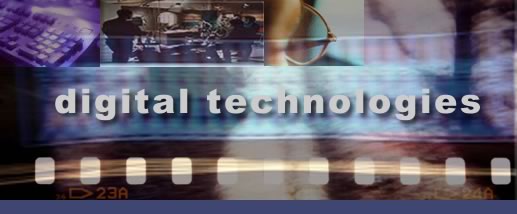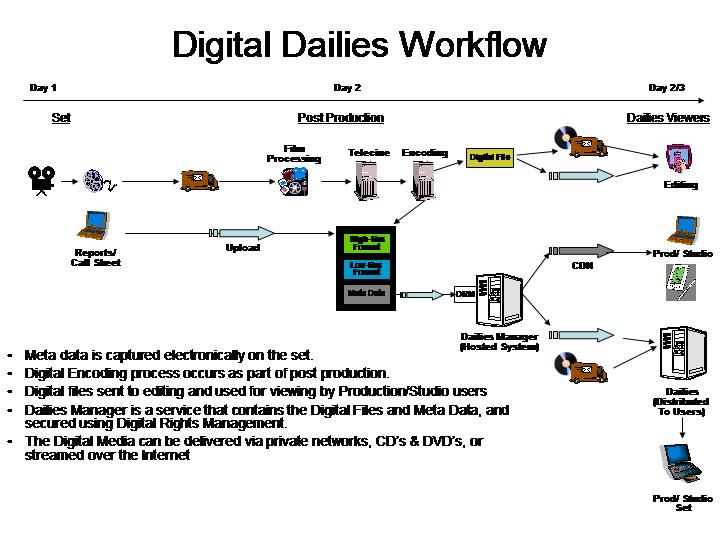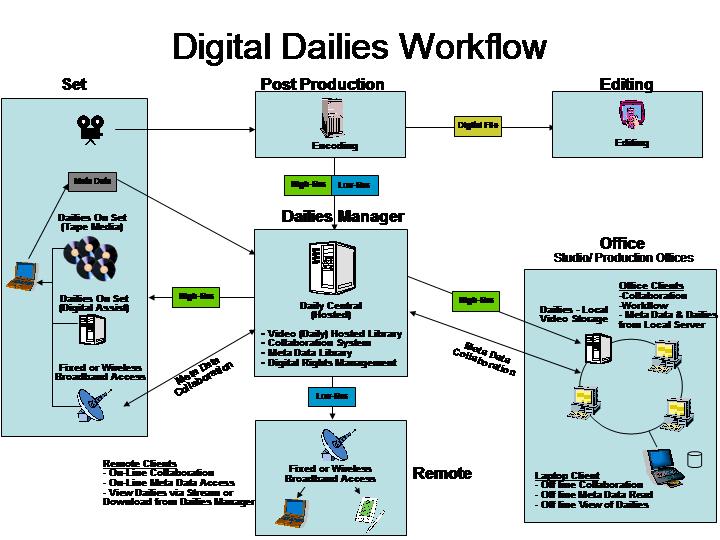
Digital
Dailies
What the heck is that?
By Mark J. Kapczynski
So
what are Digital Dailies anyway? Every Post House, every film industry
magazine, every technology provider thinks that they are the greatest
thing since sliced bread. Let’s slice in to the proverbial loaf of
Digital Dailies and see what we can find inside…
In case you have no idea what dailies are—these are the seeming endless
VHS tapes that we collect during production and store on shelves; just
in case one day we need them. More realistically, dailies are a film print,
video tape, or now digital format or the footage shot during the day of
production. If you are from Europe, you might call them "rushes".
Because laboratories "rush" to have them developed overnight
so the creative team can view them during production.
There is a basic workflow: You shoot film on the set each day, and then
have a lab process the film overnight. After processing, the lab will
make a one-light print and/or telecine of the footage.

The
output of the telecine is to tape and/or digital format. From this "master"
tape coming out of the telecine, many lower resolution duplicates are
made; and then shipped out to various recipients. When you are ready to
watch dailies, you arm yourself with pen/pad of paper, remote control
for the VHS deck and TV; and can navigate countless VHS tapes.
There are a number of different types of digital dailies technologies.
Before we can start to figure these out, we must identify user communities
for these dailies. Each one of the following groups has its own unique
requirement and expectations for digital dailies.
1- Directors – need to use dailies to check performances, framing
and cinematic looks
2- Cinematographers and Camera Crew – ideally want to see a print
of the dailies to check colors, lighting and focus
3- Producers – want to see the production coming along, and the shots
in dailies that match script, budget, and schedule
4- Studio Executives – want to see their "baby"
5- Editors – need dailies as a source format to ingest into an Avid
or other non linear editing system to begin making edits
6- Others – potentially investors and people related to the film
may request copies of the dailies footage

There are some key technologies which must also be remembered when choosing
a digital dailies solution:
1- Hosting – Streaming vs. Downloading – How are the digital
dailies made available to you? Do you have to stream the online? Or download
them to view them? Or do you have to be connected to a "private"
network to access them? Depending on where you are in the world, you might
have access to high or low amounts of network bandwidth. Today –
you can even bring a portable high-speed internet connection with you
when you travel to remote location, using a satellite dish to connect
back to the network. Other times, you might be stuck with a dial-up modem
connection and have to watch low-res proxies of your dailies using consumer
grade streaming technology like Real Networks.
2- Security & Digital Rights Management – how secure are the
digital dailies files? Are fillies encrypted using a DRM technology? Do
they include a watermark? Using DRM will ensure that if someone wrongfully
receives the digital files, that without a digital license, they will
not be able to view the dailies.
3- Security & Access Controls – Sometimes you do not want certain
user communities within the production team to see dailies. Sometimes
the director wants to see all the dailies first, before the studio execs
or the producers can see them. This is done out of control or done out
of quality assurance. SO make sure that you can define a set of access
controls so that only the specific people that you want to see dailies,
and when…can see them.
4- Physical Media – CD, DVD, Tape – How do you want your digital
dailies delivered to you? You might want them on a DVD so that you can
watch them at home on a standard DVD player. In this case, the post-house
might even include a simple menu to navigate the DVD. In other cases,
receiving the dailies as digital formats on high-end tape formats can
make it easy to ingest for your editors to begin cutting scenes.
5- Application Services – Workflow and Collaboration – what
kind of software comes with your digital dailies? You might want to annotate
the video or even type in some notes regarding the dailies, and make sure
the team gets those notes. A good example of this workflow capability
is circle takes – you need to let the editors know which takes to
use. The integration of workflow, collaboration, annotation, and email
provides rich new services that cannot be achieved with tape-based dailies;
you can only do this in the digital world.
6- Display and Control – TV & Remote Controls – as part
of working in the digital world you have so many new capabilities. One
of which is to view digital dailies via a DVD player, computer, or Digital
Set-top box, while ensuring secure delivery, rich collaboration tools
and an easy to use interface. Think of having an integrated digital dailies
system that allows you to watch your dailies, take and share notes about
the dailies, and prepare the dailies for editing.

Digital dailies
can be a great tool to enable further creativity while offering new capabilities
for collaboration, security, and access to dailies. Most post-houses can
get digital dailies to the production team faster than delivering them
on tape formats. This becomes especially true on remote locations. In
this case, it takes too long to ship the tapes back and forth. Using digital
technology via computers and the internet, you can access the dailies
from anywhere. This universal access to secure digital dailies can have
a cost impact, and save up to $150,000 on larger productions depending
on footage shot. This amount does not factor in the amount of money saved
via the software collaboration tools.
The key thing for you as a producer is to not settle for what someone
gives to you as digital dailies. Most often – digital dailies will
cost more than VHS tapes. So make sure that from a buyer’s perspective
you have the knowledge as to whom on your crew needs digital dailies and
in what manner should they be viewed or received.-MK
|
|
Contributing
writers
|
|

Mark
Kapczynski
President
and CEO of MESOFT. Mr. Kapczynski has over eleven years of computer
technology experience and thirteen years of Media & Entertainment
experience, most recently as Principal for the Worldwide Media and
Entertainment Solutions Group for Microsoft Corporation. While at
Microsoft, Mr. Kapczynski developed the Microsoft Digital Content
Solution Strategy/Framework and managed the development of key applications/solutions
for the media industry including Video on Demand, Digital Dailies,
D-Cinema, and Digital Distribution. He was instrumental in securing
key wins from EMI Digital Warehouse, Disney Digital Dailies, Sony
Movielink VOD, and CBS newspath. Mr. Kapczynski is a prominent speaker
in the media industry and has given numerous presentations at such
top venues as NAB, IBC, Comdex, Digital Hollywood, FilmIT, and the
Cannes Film Festival. He is on the Board of Advisors of Galvanon
Inc. and Digimine Inc., and is an SMPTE member, active on the W25
Metadata/Wrapper Technology and N26 File Management and Networking
Technology committees. He has a B.A. in Film from UCLA.

Freddy Goeske
Mr. Goeske has over decade over a decade of experience in both computer
technology and post-production. He is currently the Vice President
and Director of Technology for MESoft Partners, LLC. a media and
entertainment software development company. Most recently Mr. Goeske
was contracted by Microsoft to help develop Digital Dailies and
Digital Assist solutions using Windows Media technologies.
In 1996 Mr. Goeske confounded Engram Digital and served as its Chief
Technical Director until early 2002. During his tenure at Engram
he was responsible for resolution independent digital postproduction
services including 2D composting, 3D animation, and non-linear editing.
While at Engram Mr. Goeske consulted as a Visual Effects and Postproduction
Effects Supervisor on several feature films and Television shows.
Additionally, he Executive Produced the feature film "Postmortem"
staring Charlie Sheen and several direct to video productions.
Since early 1999, Freddy has concentrated his efforts on developing
the post-production environment of the future. He has collaborated
with fellow filmmakers to help create the "Hi-Def Alliance
Studio Group" an organization-committed advancement of Hi-Def
filmmaking. Working with the alliance members, Steve Bratter of
Bratter Broadband & David Effress of Smart Films, he was instrumental
in delivering HDCAM tape-to-film output to the 2000 Sundance Film
Festival that was unrivaled in its filmic quality.
|
State
of the Union
11/10/2002
Technology for the Independent Film/TV Producer
By Mark J. Kapczynski
The
Digital Intermediate
Process
By Freddy Goeske 11/23/2002:
|
